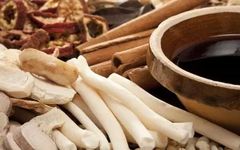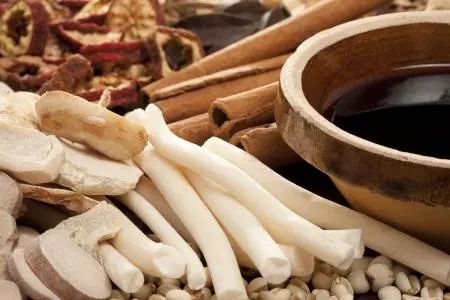
Bai Shao
Cynanchum otophyllum
Source
Bai Shao is a plant of the Ranunculaceae family, specifically the dried root of the peony (Paeonia). It grows in mountainous areas, valleys, and along roadsides at altitudes of 1500-2800 meters.
Image
Origin
Produced in provinces such as Zhejiang, Anhui, Guizhou, Yunnan, Sichuan, and Tibet.
Morphological Characteristics
Perennial herbaceous vine; root cylindrical, gray-black, approximately 8 mm in diameter; stem covered with two rows of hairs. Leaves are opposite, membranous, ovate-lanceolate, 7-10 cm long, 4-8 cm wide at the base, gradually tapering to a point at the top, with deeply heart-shaped auricles at the base, rounded and drooping on both sides covered with soft hairs. Umbellate cymes are axillary, with over 20 flowers; calyx covered with fine hairs on the outside, with 5 glands on the inner base; corolla white, lobes elongated, with fine hairs inside; the corona is cup-shaped, slightly longer than the staminal crown, with a small tooth in the middle of the lobes, or with folds or notches; pollen sacs contain one per chamber, drooping; the stigma is slightly bifid at the top. The follicles are paired or only one develops, short lanceolate, about 8 cm long, 1 cm in diameter, tapering towards the end, with a narrow base, and the outer pericarp has longitudinal stripes; seeds are oval, 6 mm long, 3 mm wide; seed hairs are white and silky, 3 cm long. Flowering period is from June to October, fruiting period from August to November.
Medicinal Part
The dried root of the Ranunculaceae family Bai Shao genus plants.
Properties and Channels
Properties: Cool, bitter, slightly cold
Channels: Liver, Spleen
Functions and Indications
Used for blood deficiency with sallow complexion, irregular menstruation, spontaneous sweating, night sweats, flank pain, abdominal pain, limb cramps, headache, and dizziness.
Medicinal Value
1. Bai Shao nourishes blood and softens the liver, and can also pacify liver yang, used for headaches and dizziness caused by insufficient liver yang or excessive liver yang, often combined with Niuxi (Achyranthes), Dai Zhe Shi (Hematite), etc.
2. Bai Shao has the effect of astringing yin and stopping sweating. It is used for external wind-cold with spontaneous sweating due to deficiency, often combined with Gui Zhi (Cinnamon Twig), Sheng Jiang (Fresh Ginger); for night sweats caused by yin deficiency and yang floating, combined with Mu Li (Oyster Shell), Long Gu (Dragon Bone) to enhance the effect of astringing yin and stopping sweating.
3. Bai Shao, with its sour taste entering the liver, is good at nourishing blood and astringing yin. Due to its cold nature, it is often used for blood deficiency with heat symptoms. It is used for irregular menstruation and abdominal pain during menstruation due to insufficient yin blood, often combined with Dang Gui (Angelica), Shu Di Huang (Rehmannia), Chuan Xiong (Ligusticum), enhancing the function of nourishing blood and regulating menstruation, known as Si Wu Tang (Four Substance Decoction). If there is severe abdominal pain during menstruation, it can be combined with Dang Gui, Xiang Fu (Cyperus). For blood deficiency causing prolonged bleeding, pale complexion, palpitations, and shortness of breath, it is often combined with Dang Gui, Ejiao (Donkey-hide Gelatin).
4. Bai Shao nourishes blood and softens the liver, and can also relieve pain. It is used for flank pain caused by blood deficiency and liver stagnation, or for abdominal pain and breast distension in women during menstruation, often combined with Dang Gui, Chai Hu (Bupleurum); for acute abdominal pain due to liver-spleen disharmony and limb pain caused by blood deficiency, often combined with Gan Cao (Licorice); it can also be used to treat abdominal pain and diarrhea, often combined with Fang Feng (Siler), Bai Zhu (White Atractylodes) for diarrhea and abdominal pain, and often combined with Huang Lian (Coptis), Mu Xiang (Aucklandia).
Identification Methods
Characteristics of the Medicinal Material
It is cylindrical, straight or slightly curved, with flat ends, 5-18 cm long, and 1-2.5 cm in diameter. The surface is whitish or light brownish-red, smooth or with longitudinal wrinkles and fine root marks, occasionally with remnants of brownish-black outer skin. It is solid, not easily broken, with a relatively flat cross-section, whitish or slightly brownish-red, with distinct growth rings and radiating rays. The aroma is faint, with a slightly bitter and sour taste.
Characteristics of the Processed Slices
Bai Shao appears as thin, round slices. The surface is light brownish-red or whitish, smooth. The cut surface is whitish or slightly brownish-red, with distinct growth rings, and slightly raised vein patterns arranged radially. The aroma is faint, with a slightly bitter and sour taste.
Customer Service Hotline for Heng Likang Enzyme Factory: 4006687739 (Source: Internet)

Editor: Yin Yanwei Reviewers: Zhang Yabin, Liang Zebao


